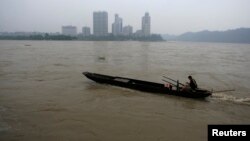BEIJING —
China's environment ministry has given the go-ahead for the construction of what will become the country's tallest hydroelectric dam despite acknowledging it will have an impact on plants and rare fish.
The dam, with a height of 314 meters (1,030 feet), will serve the Shuangjiangkou hydropower project on the Dadu River in southwestern Sichuan province.
To be built over 10 years by a subsidiary of state power firm Guodian Group, it is expected to cost 24.68 billion yuan ($4.02 billion) in investment.
The ministry, in a statement issued late on Tuesday, said an environmental impact assessment had acknowledged that the project would have a negative impact on rare fish and flora and affect protected local nature reserves.
Developers, it said, had pledged to take "countermeasures'' to mitigate the effects. The project still requires the formal go-ahead from the State Council, China's cabinet.
China aims to raise the share of non-fossil fuels in its energy mix to 15 percent by 2020, up from 9.4 percent in 2011. Hydropower is expected to make the biggest contribution.
It has vowed to speed up construction of dams in the 2011-2015 period after slowing it down following the completion of the controversial Three Gorges project in 2006.
The Three Gorges Dam, which serves the world's biggest hydropower station on the Yangtze river, measures 185 meters.
The 300-m Nurek dam in Tajikistan in Central Asia is the world's highest, though other taller dams are now under construction. China's tallest dam now, at 292 meters, is the Xiaowan Dam on the Lancang River, also known as the Mekong.
On completion, the Sichuan project will have a total installed capacity of 20 gigawatts (GW), with annual power generation to exceed 7 billion kilowatt-hours (kWh).
The government said this year that hydropower capacity was expected to reach 290 GW by 2015, up from 220 GW at the end of 2010. It also said it would begin building a controversial project on the undeveloped Nu River in Yunnan province.
Guodian was one of a number of state-owned firms criticized by China's national audit office last week for starting work on projects not yet been approved by the central government. The office said by the end of 2011, the company had invested nearly 30 billion yuan in 21 unapproved projects.
The Huaneng Group, China's biggest power company, was also criticized for launching construction of the Huangdeng hydropower plant before receiving the government's go-ahead. ($1 = 6.1428 Chinese yuan)
The dam, with a height of 314 meters (1,030 feet), will serve the Shuangjiangkou hydropower project on the Dadu River in southwestern Sichuan province.
To be built over 10 years by a subsidiary of state power firm Guodian Group, it is expected to cost 24.68 billion yuan ($4.02 billion) in investment.
The ministry, in a statement issued late on Tuesday, said an environmental impact assessment had acknowledged that the project would have a negative impact on rare fish and flora and affect protected local nature reserves.
Developers, it said, had pledged to take "countermeasures'' to mitigate the effects. The project still requires the formal go-ahead from the State Council, China's cabinet.
China aims to raise the share of non-fossil fuels in its energy mix to 15 percent by 2020, up from 9.4 percent in 2011. Hydropower is expected to make the biggest contribution.
It has vowed to speed up construction of dams in the 2011-2015 period after slowing it down following the completion of the controversial Three Gorges project in 2006.
The Three Gorges Dam, which serves the world's biggest hydropower station on the Yangtze river, measures 185 meters.
The 300-m Nurek dam in Tajikistan in Central Asia is the world's highest, though other taller dams are now under construction. China's tallest dam now, at 292 meters, is the Xiaowan Dam on the Lancang River, also known as the Mekong.
On completion, the Sichuan project will have a total installed capacity of 20 gigawatts (GW), with annual power generation to exceed 7 billion kilowatt-hours (kWh).
The government said this year that hydropower capacity was expected to reach 290 GW by 2015, up from 220 GW at the end of 2010. It also said it would begin building a controversial project on the undeveloped Nu River in Yunnan province.
Guodian was one of a number of state-owned firms criticized by China's national audit office last week for starting work on projects not yet been approved by the central government. The office said by the end of 2011, the company had invested nearly 30 billion yuan in 21 unapproved projects.
The Huaneng Group, China's biggest power company, was also criticized for launching construction of the Huangdeng hydropower plant before receiving the government's go-ahead. ($1 = 6.1428 Chinese yuan)








